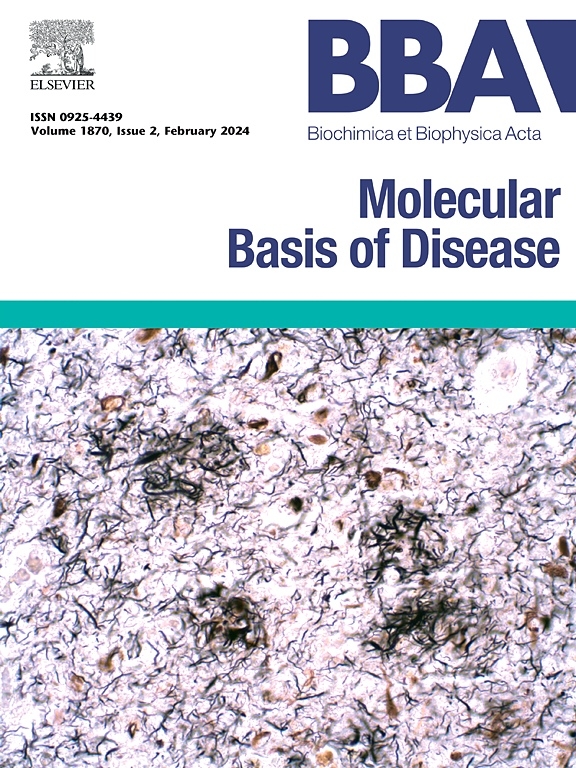From aging to space: A comparative biology of skeletal muscle degeneration
IF 4.2
2区 生物学
Q2 BIOCHEMISTRY & MOLECULAR BIOLOGY
Biochimica et biophysica acta. Molecular basis of disease
Pub Date : 2025-09-18
DOI:10.1016/j.bbadis.2025.168058
引用次数: 0
Abstract
Sarcopenia, the progressive loss of skeletal muscle mass and function with age, represents a major clinical concern, particularly in the context of disuse and unloading conditions such as simulated microgravity. This review explores the molecular, cellular, and physiological responses of skeletal muscle to simulated microgravity and compares them with those observed during aging-associated sarcopenia. A central focus is placed on impaired excitation–contraction coupling, altered calcium homeostasis, and dysregulation of signalling pathways critical for muscle maintenance. Simulated microgravity induces rapid suppression of the IGF-1/Akt/mTOR axis, activation of FOXO-mediated proteolysis, and mitochondrial dysfunction via AMPK-PGC-1α inhibition, paralleling but accelerating the trajectory observed with aging. Unique to the effects of simulated microgrvity is the early upregulation and partial reversibility of myostatin-Smad signalling and autophagy activation, which diverge in pattern and timing from aging. Additionally, mechanotransduction pathways such as YAP/TAZ and redox-sensitive systems like NRF2 respond differently in simulated microgravity and sarcopenia. We further highlight the emerging role of neuromuscular junction (NMJ) instability, fiber-type switching, and nuclear calcium signalling in both contexts, emphasizing their contribution to excitation–transcription coupling and long-term muscle adaptation. The insights from simulated microgravity models not only deepen our mechanistic understanding of sarcopenia but also offer a controlled platform to explore interventions. By delineating the overlapping and distinct molecular signatures of disuse-induced and age-related muscle loss, this review provides a foundation for developing targeted countermeasures for muscle atrophy in both clinical and spaceflight settings.
从衰老到太空:骨骼肌退化的比较生物学
骨骼肌减少症,骨骼肌质量和功能随着年龄的增长而逐渐丧失,是一个主要的临床问题,特别是在废弃和卸载条件下,如模拟微重力。这篇综述探讨了骨骼肌对模拟微重力的分子、细胞和生理反应,并将它们与衰老相关的肌肉减少症进行了比较。中心焦点放在兴奋-收缩耦合受损,钙稳态改变,以及对肌肉维持至关重要的信号通路失调。模拟微重力诱导IGF-1/Akt/mTOR轴的快速抑制,foxo介导的蛋白水解的激活,以及通过AMPK-PGC-1α抑制的线粒体功能障碍,与衰老观察到的轨迹平行但加速。模拟微重力的独特影响是肌生成抑制素- smad信号和自噬激活的早期上调和部分可逆性,这些信号和自噬激活在模式和时间上与衰老不同。此外,YAP/TAZ等机械转导通路和NRF2等氧化还原敏感系统在模拟微重力和肌肉减少症中的反应不同。我们进一步强调了神经肌肉连接(NMJ)不稳定性、纤维类型转换和核钙信号在这两种情况下的新作用,强调了它们对兴奋-转录耦合和长期肌肉适应的贡献。来自模拟微重力模型的见解不仅加深了我们对肌肉减少症的机制理解,而且为探索干预措施提供了一个可控的平台。通过描述废用诱导和年龄相关肌肉损失的重叠和不同的分子特征,本综述为在临床和航天环境中制定有针对性的肌肉萎缩对策提供了基础。
本文章由计算机程序翻译,如有差异,请以英文原文为准。
求助全文
约1分钟内获得全文
求助全文
来源期刊
CiteScore
12.30
自引率
0.00%
发文量
218
审稿时长
32 days
期刊介绍:
BBA Molecular Basis of Disease addresses the biochemistry and molecular genetics of disease processes and models of human disease. This journal covers aspects of aging, cancer, metabolic-, neurological-, and immunological-based disease. Manuscripts focused on using animal models to elucidate biochemical and mechanistic insight in each of these conditions, are particularly encouraged. Manuscripts should emphasize the underlying mechanisms of disease pathways and provide novel contributions to the understanding and/or treatment of these disorders. Highly descriptive and method development submissions may be declined without full review. The submission of uninvited reviews to BBA - Molecular Basis of Disease is strongly discouraged, and any such uninvited review should be accompanied by a coverletter outlining the compelling reasons why the review should be considered.

 求助内容:
求助内容: 应助结果提醒方式:
应助结果提醒方式:


